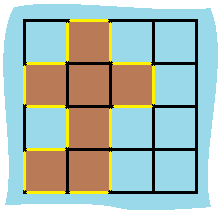Problem 49. Group Anagrams
-
Given an array of strings
strs, group the anagrams together. You can return the answer in any order. -
An Anagram is a word or phrase formed by rearranging the letters of a different word or phrase, typically using all the original letters exactly once.
Examples
-
Example 1:
- Input: strs = ["eat","tea","tan","ate","nat","bat"]
- Output: [["bat"],["nat","tan"],["ate","eat","tea"]]
-
Example 2:
- Input: strs = [""]
- Output: [[""]]
-
Example 3:
- Input: strs = ["a"]
- Output: [["a"]]
Constraints
1 <= strs.length <= 10^40 <= strs[i].length <= 100strs[i]consists of lowercase English letters.
Solution
/**
* @param {string[]} strs
* @return {string[][]}
*/
var groupAnagrams = function(strs) {
let anagramObj = {};
for (const word of strs) {
const sortedWord = word.split('').sort().join('');
if (anagramObj[sortedWord]) {
anagramObj[sortedWord].push(word);
} else {
anagramObj[sortedWord] = [word];
}
}
return Object.values(anagramObj);
};Problem 2390. Removing Stars From a String
-
You are given a string
s, which contains stars*. -
In one operation, you can:
-
Choose a star in
s.- Remove the closest non-star character to its left, as well as remove the star itself.
- Return the string after all stars have been removed.
-
Note:
- The input will be generated such that the operation is always possible.
- It can be shown that the resulting string will always be unique.
Examples
-
Example 1:
- Input: s =
"leet**cod*e" - Output: "lecoe"
- Explanation:
- Performing the removals from left to right:
- The closest character to the 1st star is 't' in
"leet**cod*e". s becomes"lee*cod*e". - The closest character to the 2nd star is 'e' in
"lee*cod*e". s becomes"lecod*e". - The closest character to the 3rd star is 'd' in
"lecod*e". s becomes"lecoe". - There are no more stars, so we return
"lecoe".
- Input: s =
-
Example 2:
- Input: s =
"erase*****" - Output: ""
- Explanation:
- The entire string is removed, so we return an empty string.
- Input: s =
Constraints
1 <= s.length <= 10^5sconsists of lowercase English letters and stars*.- The operation above can be performed on
s.
Solution
/**
* @param {string} s
* @return {string}
*/
var removeStars = function(s) {
const stack = [];
for (let i = 0; i < s.length; i++) {
const str = s[i];
if (str === '*') {
stack.pop();
} else {
stack.push(str)
}
}
return stack.join('');
};Problem 463. Island Perimeter
-
You are given
row x colgridrepresenting a map wheregrid[i][j] = 1represents land andgrid[i][j] = 0represents water. -
Grid cells are connected horizontally/vertically (not diagonally). The
gridis completely surrounded by water, and there is exactly one island (i.e., one or more connected land cells). -
The island doesn't have "lakes", meaning the water inside isn't connected to the water around the island. One cell is a square with side length 1. The grid is rectangular, width and height don't exceed 100. Determine the perimeter of the island.
Examples
- Example 1:
- Input: grid = [[0,1,0,0],[1,1,1,0],[0,1,0,0],[1,1,0,0]]
- Output: 16
- Explanation: The perimeter is the 16 yellow stripes in the image below.

- Example 2:
- Input: grid = [[1]]
- Output: 4
Constraints
row == grid.lengthcol == grid[i].length1 <= row, col <= 100grid[i][j]is0or1.- There is exactly one island in
grid.
Solution
/**
* @param {number[][]} grid
* @return {number}
*/
var islandPerimeter = function(grid) {
const row = grid.length;
const col = grid[0].length;
let totalPerimeter = 0;
const getPerimeter = function(rowIndex, colIndex) {
const dx = [1, -1, 0, 0];
const dy = [0, 0, 1, -1];
let perimeter = 4;
for (let i = 0; i < dx.length; i++) {
const nextRow = rowIndex + dx[i];
const nextCol = colIndex + dy[i];
if (nextRow < 0 || nextRow >= row || nextCol < 0 || nextCol >= col) {
continue;
}
if (grid[nextRow][nextCol]) {
perimeter -= 1;
}
}
return perimeter;
}
for (let i = 0; i < row; i++) {
for (let j = 0; j < col; j++) {
if (!grid[i][j]) {
continue;
}
totalPerimeter += getPerimeter(i, j);
}
}
return totalPerimeter;
};
